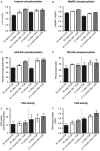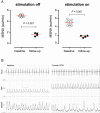Cardiac contractility modulation: mechanisms of action in heart failure with reduced ejection fraction and beyond
- PMID: 30485591
- PMCID: PMC6607484
- DOI: 10.1002/ejhf.1349
Cardiac contractility modulation: mechanisms of action in heart failure with reduced ejection fraction and beyond
Abstract
Heart failure (HF) is responsible for substantial morbidity and mortality and is increasing in prevalence. Although there has been remarkable progress in the treatment of HF with reduced ejection fraction (HFrEF), morbidity and mortality are still substantial. Cardiac contractility modulation (CCM) signals, consisting of biphasic high-voltage bipolar signals delivered to the right ventricular septum during the absolute refractory period, have been shown to improve symptoms, exercise tolerance and quality of life and reduce the rate of HF hospitalizations in patients with ejection fractions (EF) between 25% and 45%. CCM therapy is currently approved in the European Union, China, India, Australia and Brazil for use in symptomatic HFrEF patients with normal or slightly prolonged QRS duration. CCM is particularly beneficial in patients with baseline EF between 35% and 45%, which includes half the range of HF patients with mid-range EFs (HFmrEF). At the cellular level, CCM has been shown in HFrEF patients to improve calcium handling, to reverse the foetal myocyte gene programme associated with HF, and to facilitate reverse remodelling. This review highlights the preclinical and clinical literature related to CCM in HFrEF and HFmrEF and outlines the potential of CCM for HF with preserved EF, concluding that CCM may fill an important unmet need in the therapeutic approach to HF across the range of EFs.
Keywords: Cardiac contractility modulation; Heart failure; Pathophysiology; Preserved ejection fraction; Treatment.
© 2018 The Authors. European Journal of Heart Failure published by John Wiley & Sons Ltd on behalf of European Society of Cardiology.
Figures



References
-
- Luscher TF. Heart failure: the cardiovascular epidemic of the 21st century. Eur Heart J 2015;36:395–397. - PubMed
-
- Liu L, Eisen HJ. Epidemiology of heart failure and scope of the problem. Cardiol Clin 2014;32:1–8, vii. - PubMed
-
- Mozaffarian D, Benjamin EJ, Go AS, Arnett DK, Blaha MJ, Cushman M, de Ferranti S, Despres JP, Fullerton HJ, Howard VJ, Huffman MD, Judd SE, Kissela BM, Lackland DT, Lichtman JH, Lisabeth LD, Liu S, Mackey RH, Matchar DB, DK MG, Mohler ER 3rd, Moy CS, Muntner P, Mussolino ME, Nasir K, Neumar RW, Nichol G, Palaniappan L, Pandey DK, Reeves MJ, Rodriguez CJ, Sorlie PD, Stein J, Towfighi A, Turan TN, Virani SS, Willey JZ, Woo D, Yeh RW, Turner MB; American Heart Association Statistics Committee and Stroke Statistics Subcommittee . Heart disease and stroke statistics‐‐2015 update: a report from the American Heart Association. Circulation 2015;131:e29–e322. - PubMed
-
- Tschöpe C, Pieske B. Heart failure with mid‐range EF (HFmrEF): a mildly reduced EF does not imply a mild disease. Heart and Metabolism 2017;74:8–12.
Publication types
MeSH terms
Substances
LinkOut - more resources
Full Text Sources
Other Literature Sources
Medical
Research Materials
Miscellaneous

